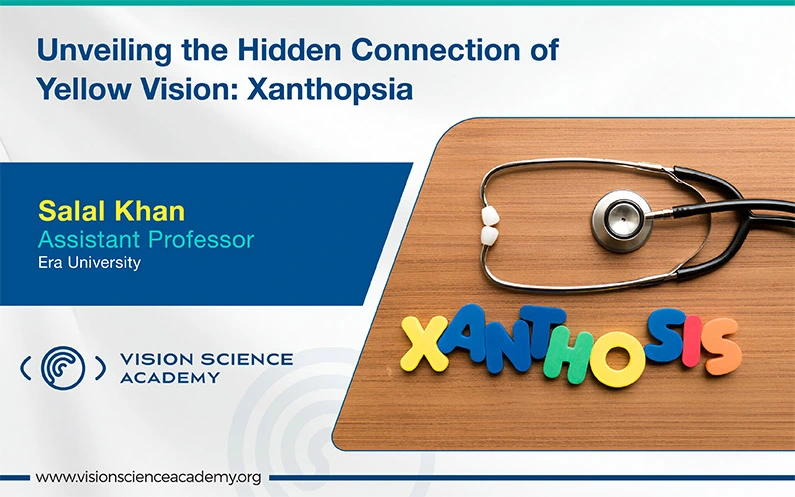Salal Khan, M.Optom, FAAO
Assistant Professor, Era University, Lucknow, India
Xanthopsia is a rare visual disorder where a person sees everything with a yellowish hue or tint. It’s as if they’re looking through yellow glasses or a yellow filter. (1,2) This condition can be caused by various factors affecting the eye or brain, including:
- Ocular diseases: There are various conditions like cataracts, age-related macular degeneration, and retinal detachment can lead to xanthopsia. (3)
- Medications: Certain medications like digoxin, quinine, and sildenafil can cause xanthopsia. (4)
- Optical factors: Abnormalities in the cornea or lens can cause xanthopsia.
- Brain disorders: There are various certain conditions like multiple sclerosis, Alzheimer’s disease, and brain tumours can affect the visual pathway and cause xanthopsia. (5)
- Systemic diseases: Various systemic conditions like carotenemia (high levels of carotenoids in the blood), jaundice, and diabetes can cause xanthopsia.
Symptoms of xanthopsia:
- Seeing objects as yellowish
- Colour perception difficulties
- Difficulty distinguishing between colours
- Blurred vision
- Sensitivity to light
Treatment for xanthopsia:
It depends on the underlying cause and may include:
- Correcting optical factors through glasses or surgery
- Filtering lenses
- Discontinuing medications that cause xanthopsia
- Treating underlying eye diseases or brain disorders
- Thiamine can be given in the dosage of 200 mg daily
- Managing systemic diseases
- Low vision rehabilitation
Role of an Optometrist:
- Comprehensive Eye Examination: Optometrist can perform a comprehensive eye examination to screen out any underlying ocular diseases that may cause xanthopsia.
- Colour vision testing: Optometrists can perform colour vision tests to rule out the extent of colour vision defects.
- Interdisciplinary Collaboration with HCPs: Optometrists can collaborate with ophthalmologists, neurologists, and other health care professionals to provide comprehensive care for patients with xanthopsia.
- Low vision rehabilitation: Optometrists can also provide low vision rehabilitation services to help patients adapt to their visual condition. (6)
- Patient education: Optometrists can educate patients about xanthopsia, its causes, symptoms and management options.
- Patient Counselling: Optometrists should offer counselling to help patients cope with the emotional and psychological aspects of xanthopsia.
In some cases, xanthopsia may be irreversible, and the goal of treatment is to improve visual function and quality of life. Thus, optometrists play an integral role in xanthopsia management by providing comprehensive eye examination, correcting refractive errors, managing cataract and offering patient education and counselling.
Reference
- Xanthopsia:https://www.sciencedirect.com/topics/medicine-and-dentistry/xanthopsia, Accessed on 20 Jul 2024.
- Gruener, A. (2013). Vincent van Gogh’s yellow vision. British Journal of General Practice, 63(612), 370-371.
- Xanthopsia:https://vitreum.ro/en/ophthalmological-dictionary/xanthopsia/#:~:text=Xantopsia%20is%20a%20visual%20disorder,the%20eyes%20or%20nervous%20system. Accessed on 21 Jul 2024.
- Haruna, Y., Kawasaki, T., Kikkawa, Y., Mizuno, R., & Matoba, S. (2020). Xanthopsia due to digoxin toxicity as a cause of traffic accidents: a case report. The American Journal of Case Reports, 21, e924025-1.A Dictionary of Neurological Signs. Springer, New York, NY.(2006) https://doi.org/10.1007/0-387-31217-X_24
- Corn, A.L. (2019). Low vision rehabilitation, Foundation of low vision: Clinical and functional perspectives. New York, pp. 3-14.


Recent Comments